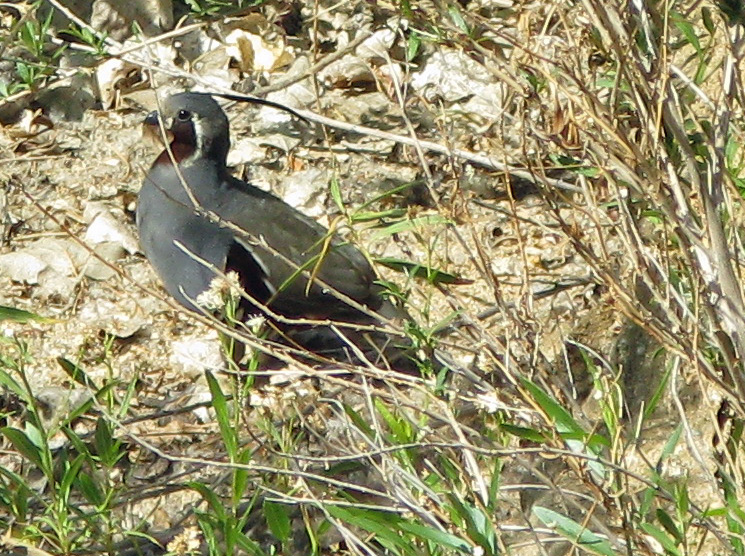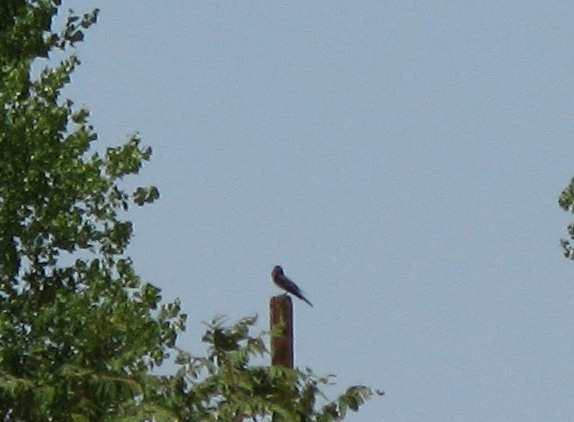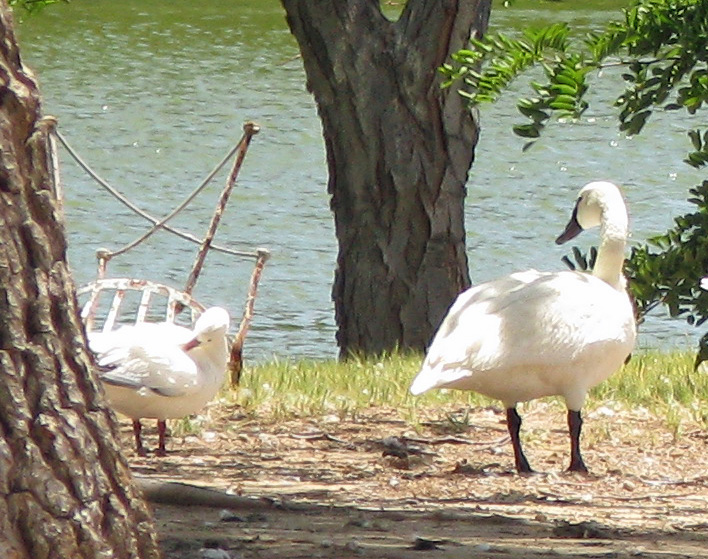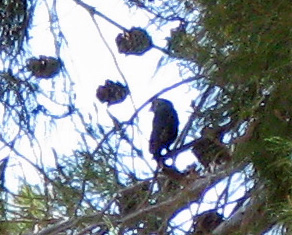#428-#432 in the Mojave Desert
I’m still quite new to Southern California. The good part of that is that there are still lots of life birds to see here. The bad part is I often don’t realize exactly where they are, as was proven conclusively last weekend. I’d signed up for a Sea & Sage Audubon trip to Butterbredt Springs & Galileo Hill. It was meeting in Mojave, but exact directions were to be given later. Sea & Sage is the Orange County Audubon chapter so I figured Mojave must be somewhere in the Eastern part of the county.
When I actually pulled up Google Maps and looked at it a few days before we were scheduled to leave, let’s just say I was more than a little shocked. It was north east of Los Angeles, about 100 miles and 2 hours and 15 minutes away, if I didn’t get lost and there wasn’t any traffic. However we were meeting at 6:15 AM in Mojave so probably I didn’t have to worry too much about traffic. On the downside that meant I had to be up by about 3:00 A.M. to make the meeting. I don’t even get up at 3:00 A.M. for pelagics!
When Nancy called me to confirm on Saturday morning I was very iffy, but then I made the mistake of reading up on the sites we were visiting in my recently acquired A Birder’s Guide to Southern California, and saw all the great birds we might see out there. I figured the opportunity was too good to miss, so I went to bed at 8:00 P.M. the night before, and was on the road by 3:30 A.M.
Interesting factoid: there really is no traffic on the highways of Orange County at 3:30 A.M. on Sunday. It’s like driving through the back roads of Louisiana at night. In New York City, there’s always some traffic. These highways were really deserted though. When I crossed over into L.A. proper, traffic picked up a bit. I was no longer the only car visible on the road, but when I passed Griffith Park and headed out into the desert that all vanished, until dawn broke sometime after 5:30 A.M.
I arrived a little early, and grabbed a quick breakfast and desperately needed coffee at the local Mojave Denny’s. The it was off to the meetup at Carl’s Jr., where I learned that we were not in fact car pooling from there, so some more coffee seemed like a good idea. On the plus side: if I fell asleep at the wheel the most likely scenario seemed to be that I would wander off across the desert for a few miles, since there was pretty mchh nothing else around.
From Mojave we drove to Jawbone Canyon, and then carpooled form there down a bumpy dirt road to Butterbredt Springs, a local migrant trap where we arrived around 7:30 A.M. An eastern vagrant Golden-winged Warbler had been reported there the previous day, and everyone was very excited about it. (Well, except me of course. I was more excited about local residents like Sage Sparrow and Mountain Quail.)
First bird we pulled was a Red-winged Blackbird. For this I set my alarm for 3:00 A.M.? But as we moved in the birds picked up. Next up was a beautiful Western Kingbird, and then the first of several Mourning Doves. Bewick’s Wrens were calling, and House Finches were everywhere (as they usually are in California).
The first really interesting bird was a male Indigo Bunting. This is an another Eastern vagrant, though I didn’t realize it at the time. That was shortly followed by several Western Tanagers (locals). Yellow and Wilson’s Warblers were both present, along with the ubiquitous Pacific-slope Flyctachers. Slightly more surprising we found an Ash-throated Flycatcher, then a Ladder-backed Woodpecker (a life bird for me just two weekends ago).
One tree in particular across a small ravine was a hotbed of activity including Warbling Vireo and Northern Parula, our second vagrant. Lesser Goldfinches and Swainson’s Thrushes were behind us. (360 degree birding was a necessity.)
Then, at 8:12 A.M. we spot a Lark Sparrow! #428! or was it? Well, no it wasn’t. After much inspection and argument we decided it was a Clay-colored Sparrow (but the story on that bird wasn’t over). Lawrence’s Goldfinches flew in behind us.
We could have stayed there for hours, but we decided to move down into the canyon a little ways. California Quail started calling as the sun warmed up, and the first Hummingbirds (Anna’s showed up). I was hoping for Black-chinned, Costa’s or Calliope but I’ll take an Anna’s. At 8:34 we heard the distinctive “Fitz-bew” of a Willow Flycatcher, and then spotted a Desert Spiny Lizard (a life herp for me).
At 8:45 while half the group is up ahead, the other half of the group spots an unmistakable Gambel’s Quail perched on a rock at the top of the canyon It stood there facing us for quite a while and we all had good looks at the big black patch on its belly.
We walk on and catch up to the rest of the group where, after some effort, I finally get a decent look at #428, Sage Sparrow. However I miss the Brewer’s Sparrow completely. :-( Next trip I suppose.
At 8:53, #429, Mountain Quail crosses the road in front of us. Someone says, that’s our second quail. I say, “No, it’s our third.” and mention the Gambel’s Quail to the rest of the group. This causes a tizzy. Apparently there are no Gambel’s Quail up there in the high desert because John Dunne says so. I beg to differ: we saw a Gambel’s Quail. No ifs, ands, or buts. Perhaps it was released by hunters rather than being truly native but there absolutely was at least one Gambel’s Quail at Butterbredt Springs on May 31.
Eventually we turn around and make our way back to the tree by the entrance. The cryptic sparrow is still there. This time we decide it’s not a Clay-colored Sparrow after all. (Personally I never thought it was.) briefly we decide it’s a Vesper Sparrow, but the eye ring is wrong. (that is, it doesn’t have one.) Eventually despite numerous excellent views we give up and decide we just can’t figure out what this sparrow is. How frustrating. On the plus side we spend some time watching a Mountain Quail with chicks come to a small stream:

As we hike out our last bird at the springs calls, a Common Raven.
Galileo Hill
The Silver Saddle Resort is an irrigated vacation community in the middle of the desert. It really has no business being there. You can see the hard line where they stop irrigating and the nicely manicured lawns turn into desert. It’s like walking off a movie set. Nonetheless all the water does attract a lot of birds, and form a nice migrant trap, so this was our next stop.
Almost as soon as we got out of the cars, the leader found an Eastern vagrant female Hooded Warbler, but only about half the group saw it not including me. (Not to worry: I’ve seen plenty back East.) Lots of other birds were taking advantage of the water including Brewer’s Blackbirds by the dozens, Great-tailed Grackles, and Mallards. We even found a spotted Sandpiper along one of the streams.
However the highlight for me was this single Western Wood-Peewee that was just inside the property line, #430:

These show up regularly in Orange County, so it’s strange I had to go all the way to Mojave to see one, but I’ll take it where I can get it.
California City Central Park
California City Central Park is another bit of irrigated green in the desert that servs as a migrant trap. the highlight here was supposed to be an Eastern vagrant Canada Warbler. Some other groups had found it earlier, but we never did despite looking for almost two hours in a not a very large area. However we did find a resident Tundra Swan, #431:

This bird I could perhaps have found in New York, but it’s not regular there, and I’ll take it where I find it. This individual hangs out with some domestic geese and a Ross’s Goose. The Tundra Swan and the Ross’s are wild birds that have just decided the living is easy in the park. They’ve been there for a couple of years now, and don’t seem in a great hurry to go anywhere.
A little later we were clued in to a couple of nesting Red Crossbills, #432 and my last life bird of the day:

Sorry, but that’s as good as I can do for a picture; and I’m amazed I got that one. We really needed the scopes to conclusively ID these two individuals.
This is an irruptive species I’ve never seen in the east. However they’re rare but more regular around here.
My total species count for the day was 37:
- Ross’s Goose
- Tundra Swan
- Mallard
- Mountain Quail
- California Quail
- Gambel’s Quail
- Double-crested Cormorant
- Black-crowned Night-Heron
- American Coot
- Spotted Sandpiper
- Mourning Dove
- Anna’s Hummingbird
- Ladder-backed Woodpecker
- Western Wood-Pewee
- Willow Flycatcher
- Pacific-slope Flycatcher
- Vermilion Flycatcher
- Ash-throated Flycatcher
- Western Kingbird
- Warbling Vireo
- Common Raven
- Bewick’s Wren
- Swainson’s Thrush
- European Starling
- Northern Parula
- Yellow Warbler
- Wilson’s Warbler
- Sage Sparrow
- Indigo Bunting
- Red-winged Blackbird
- Brewer’s Blackbird
- Great-tailed Grackle
- House Finch
- Red Crossbill
- Lesser Goldfinch
- Lawrence’s Goldfinch
- House Sparrow
and a couple of others were seen by other party members (Yellow-headed Blackbird, Hooded Warbler, Brewer’s Sparrow). Not bad for the desert!
The drive home was interesting. I turned on the GPS and it took me a completely different route than I expected. (Down 395 to I-15, then through Riverside to Irvine.) By the time I realized we weren’t going back down 14 it was too late to go the other way. Plus the Prius seemed to be having a little trouble in the high desert. Even though I was half empty, I was only able to put a couple of gallons of gas in, and the gas gauge never changed (up or down). (Hmm, apparently I’m not the only one who’s had problems with Prius’s gas gauge.) I really didn’t want to break down on a deserted highway in the middle of the desert, but the car made it, and I was home in time for dinner. If I do this trip again, I’m definitely car pooling.
